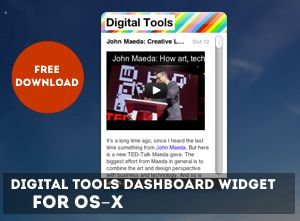This is original and some different way to “do” homebrew instruments. It is an orchestra that manufactures and plays instruments, they made 100% of vegetables. It’s interesting how many different things they build out of this garden fruits. Not only things to knock upon, but also flutes, trumpets and many other interesting things. After the show you don’t need to stay hungry: you simply can eat up the stuff you played.
Justin Frankel is the programmer of the legendary Winamp. We were interested in the “early days” of the Winamp from the beginning in 1997 until just before the Winamp went bloated with the releases after Winamp 3 in the time after AOL bought Frankel’s Nullsoft.

“Winamp, It really whips the llama’s ass!”

We talked with Justin about the early days of the Winamp, the design, the time and the decisions he made. Yet he also talks about this recent audio-tool REAPER, also in terms of design and community. In other words: things of interest for the designing developer! If you are more interested in the Winamp AOL buyout and the time Justin left… scroll down. There are some related readings linked at the bottom of this interview.
Back on 1997 Justin started his first company “Nullsoft” with the first software called “Winamp“. Winamp went so famous, that AOL bought Nullsoft in 2001 for about 80 Million Dollar. Still Winamp is one of the most popular music applications on Windows PCs. Especially the releases smaller than Version 3 (V2.6 – V2.91) are still often used and I also power it on regularly. This piece of software is one of the most loved and distributed independent music applications in the world, not only in history, but still at present.
Nullsoft also made lots of other software that is also widely in use, or had revolutionary impact, software like the SHOUTcast streaming server, the Nullsoft installer, the first decentralized peer-to-peer network Gnutella, or the high-secure closed peer-to-peer network WASTE.
![]()
Winamp. V0.2a. The first release. Memory usage: 1.3 MB.
Hi Justin, let’s start at the beginning. Why did you started doing the Winamp?
I started making Winamp, and actually pretty much all software I’ve ever created, because it was software that I wanted to be able to use. Often there is something you want to do on a computer, and no way to do it or at least no way to do it that you will enjoy.. That’s the joy in programming, you can make things to use. Winamp grew out of wanting a good, enjoyable way to listen to mp3s on a computer. It wasn’t the first mp3 player, but the mp3 players around before it were hard for me to want to use.
Robert Hodgin aka Flight404 does creative code for really a long time now. I don’t know how long ago, I guess it was about two years, he dropped most of his experiments and only concentrated on visualizing music mostly with processing. Well, what’s so special about it? I’ll tell you: the works of Robert Hodgin reached a very high level of originality. With no problem you can tell this artistry.
Robert documents his progress on his weblog. This is a good example of the artistic practice to constantly repeat a challenge that you set yourself, in order to grow and grow and reach a level very high. Or would you disagree, that you haven’t seen something like the “Weird Fishes” ever before?


PikaPika is a refreshing project from Japan, that use “long time exposure” pictures of the city at night. With colorful lights they draw characters and animations, some a little bit like games, into the night. Finally they make videos and little stories out of it. Cute colors, drawn into the night. I also enjoyed the videoclips with this uplifting music.

“Mona Lisa” from Gabriel McGovern for 1k-compo at Boing Boing Gadget.
BoingBoing is having a 1 kilobyte competition, deadline will be the 1st of May 2008. You can do whatever work you want, it only should fit into 1024 bytes of digital goodness. You can win a hard-disk as competition winner, but the file-size limit should be challenging enough to go for this compo! The submitted works should be licensed in a way, that the boingers can use it freely at Boing Boing Gadgets, so GPL or Creative Commons would be fine. Some first results are shown here.
UPDATE: The final results are published!
People, who read Digital Tools will be interested in this news: Cycling 74 released today the new version of Max, that famous graphical music programming software, used by many musicians, artists, researchers, composers and sound designers. What is so special about this update? Since digital software music technology evolved in the last few years, a major update of the “old” Max system and architecture had to be done. Max was really at the time within more of the last twenty years. With this update the future of Max should be save.

“Max for the next 20 years”
A new era of Max programming is about to start. Max 5 include major enhancements and a overall new architecture below the surface: a completely redesigned multi-processing kernel and a streamlined development environment built on a platform-independent foundation. This sound like good news. The demo is free to use for 30 days. Upgrade will cost about 200 dollar.
Everyones chipmusic-darling Goto80 hits the scene with another work of glitchart he did together with Rosa Menkman. Best to see the resulting video of them both on the Goto80-blog. Here I show you the progress of Goto80, how he did processed, searching for glitchy holes in the tracker-app. He says on his blog: “I hugged bugs to compose”. I wonder how exactly he made the glitches on the tracker.

